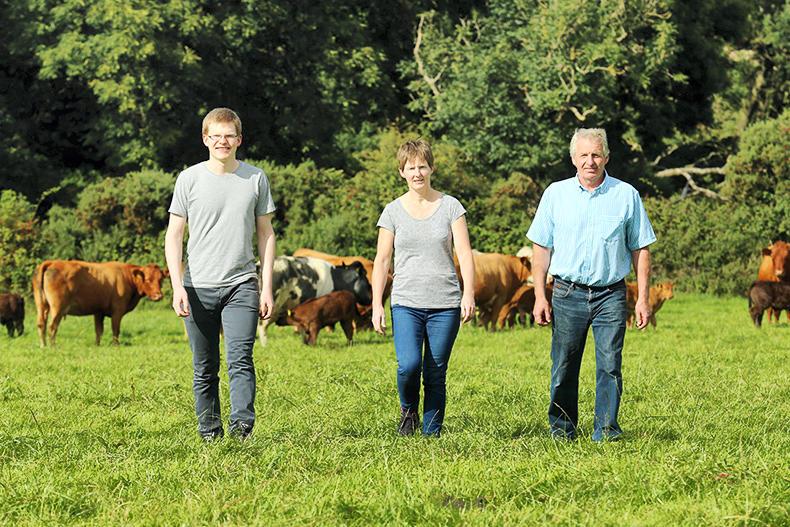Earlier this year, George and Ruth Hatton and their family sat down and pulled together their feed, electricity, fuel and fertiliser bills, soil samples and water quality results and sent them to the Smart Farming cost saving team.
All this information was examined and a half day farm visit took place. During the farm visit the Smart Farming team focused on soil fertility, energy use, grassland management, water use, feed, inputs, waste, time and machinery management.
Let’s look at where the €7,682 savings were identified:

Grassland
Develop annual reseeding plan for the farm.Where weather permits – costs can be reduced by targeting a stock turn out date of early February.For better utilisation of grass – reduce size of paddocks and rotate livestock more frequently.Bring forage harvest date forward to late May to increase bale quality.Feed
Ensure annual analysis of silage takes place.Change from nut to coarse ration and increase price checking.Machinery
An allowance should be made to replace older machinery with more efficient ones.Soil fertility
Most soils are index 1 and index 2. Index 3 is optimum.Lime deficiency on the farm is reducing grass growth.Spread 16 tonnes of lime in 2017 and 2018.5 Year programme of additional phosphorus (P) proposed. Use of organic P proposed.Time management
Consider contracting out tasks during busy periods.Inputs & waste
Wilting silage reduces effluent.Increase DM in silage and reduce concentrate feeding in spring.Reducing the climate impact by 6%
During the Smart Farming Cost Saving Study, a carbon reduction strategy for the Hatton’s farm was developed using the Carbon Navigator decision support tool developed by Teagasc and Bord Bia.
Potential to reduce greenhouse gas emissions by 6% was identified. Many of the measures, such as nitrogen efficiency and slurry spreading timing will also lead to other positive environmental outcomes and reduce risks to water quality.
Let’s take a closer look at the Carbon Navigator results:

Meet Smart Farming Farmers at the Ploughing
If you are going to the National Ploughing Championships in Screggan, Tullamore this month, why not call into the IFA stand and hear from some farmers who have benefited from the Smart Farming programme or register your interest in taking the Smart Farming cost saving challenge in 2018?

Find out more about Smart Farming at www.smartfarming.ie or contact smartfarming@ifa.ie or 01 426 0343
Earlier this year, George and Ruth Hatton and their family sat down and pulled together their feed, electricity, fuel and fertiliser bills, soil samples and water quality results and sent them to the Smart Farming cost saving team.
All this information was examined and a half day farm visit took place. During the farm visit the Smart Farming team focused on soil fertility, energy use, grassland management, water use, feed, inputs, waste, time and machinery management.
Let’s look at where the €7,682 savings were identified:

Grassland
Develop annual reseeding plan for the farm.Where weather permits – costs can be reduced by targeting a stock turn out date of early February.For better utilisation of grass – reduce size of paddocks and rotate livestock more frequently.Bring forage harvest date forward to late May to increase bale quality.Feed
Ensure annual analysis of silage takes place.Change from nut to coarse ration and increase price checking.Machinery
An allowance should be made to replace older machinery with more efficient ones.Soil fertility
Most soils are index 1 and index 2. Index 3 is optimum.Lime deficiency on the farm is reducing grass growth.Spread 16 tonnes of lime in 2017 and 2018.5 Year programme of additional phosphorus (P) proposed. Use of organic P proposed.Time management
Consider contracting out tasks during busy periods.Inputs & waste
Wilting silage reduces effluent.Increase DM in silage and reduce concentrate feeding in spring.Reducing the climate impact by 6%
During the Smart Farming Cost Saving Study, a carbon reduction strategy for the Hatton’s farm was developed using the Carbon Navigator decision support tool developed by Teagasc and Bord Bia.
Potential to reduce greenhouse gas emissions by 6% was identified. Many of the measures, such as nitrogen efficiency and slurry spreading timing will also lead to other positive environmental outcomes and reduce risks to water quality.
Let’s take a closer look at the Carbon Navigator results:

Meet Smart Farming Farmers at the Ploughing
If you are going to the National Ploughing Championships in Screggan, Tullamore this month, why not call into the IFA stand and hear from some farmers who have benefited from the Smart Farming programme or register your interest in taking the Smart Farming cost saving challenge in 2018?

Find out more about Smart Farming at www.smartfarming.ie or contact smartfarming@ifa.ie or 01 426 0343









 This is a subscriber-only article
This is a subscriber-only article








